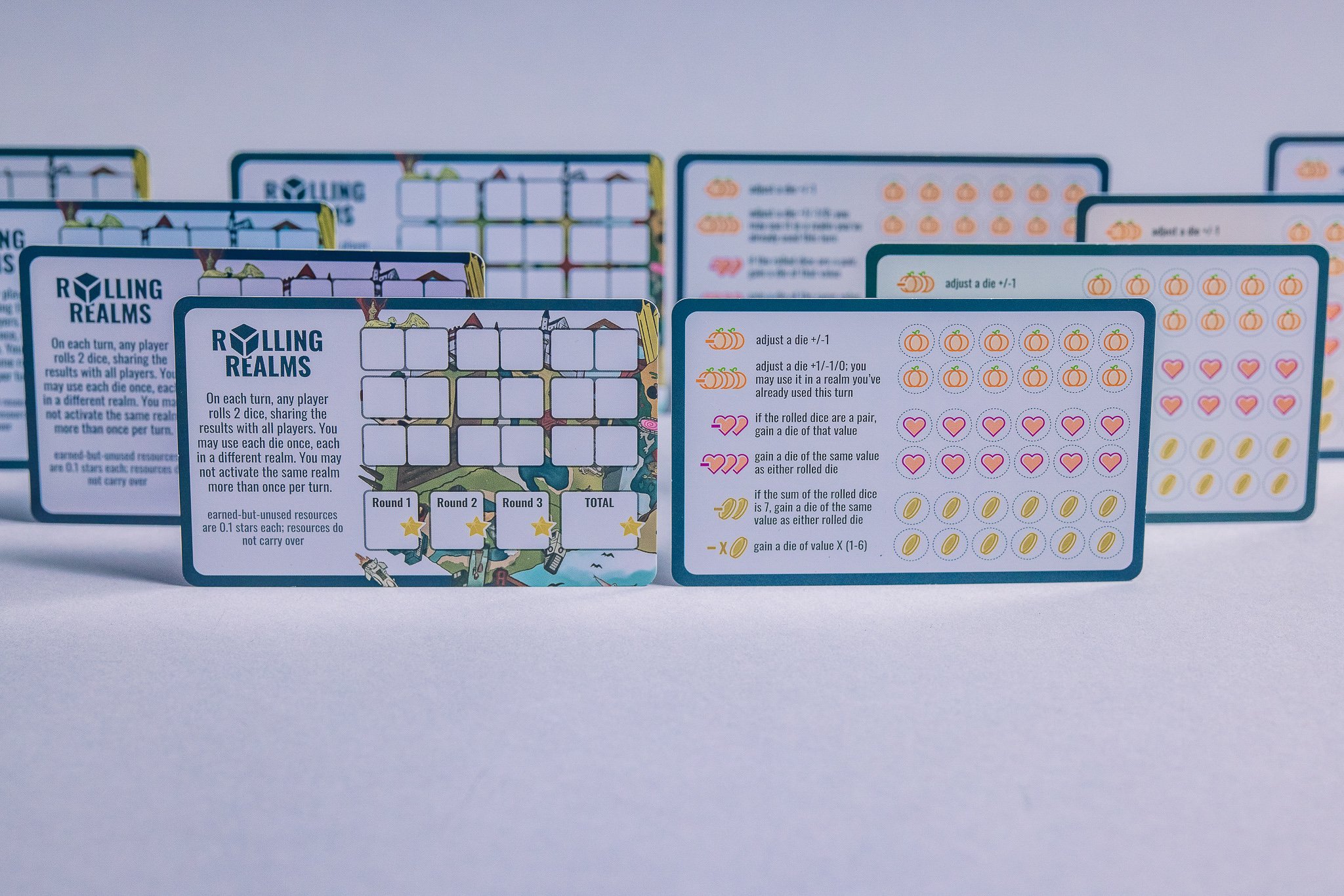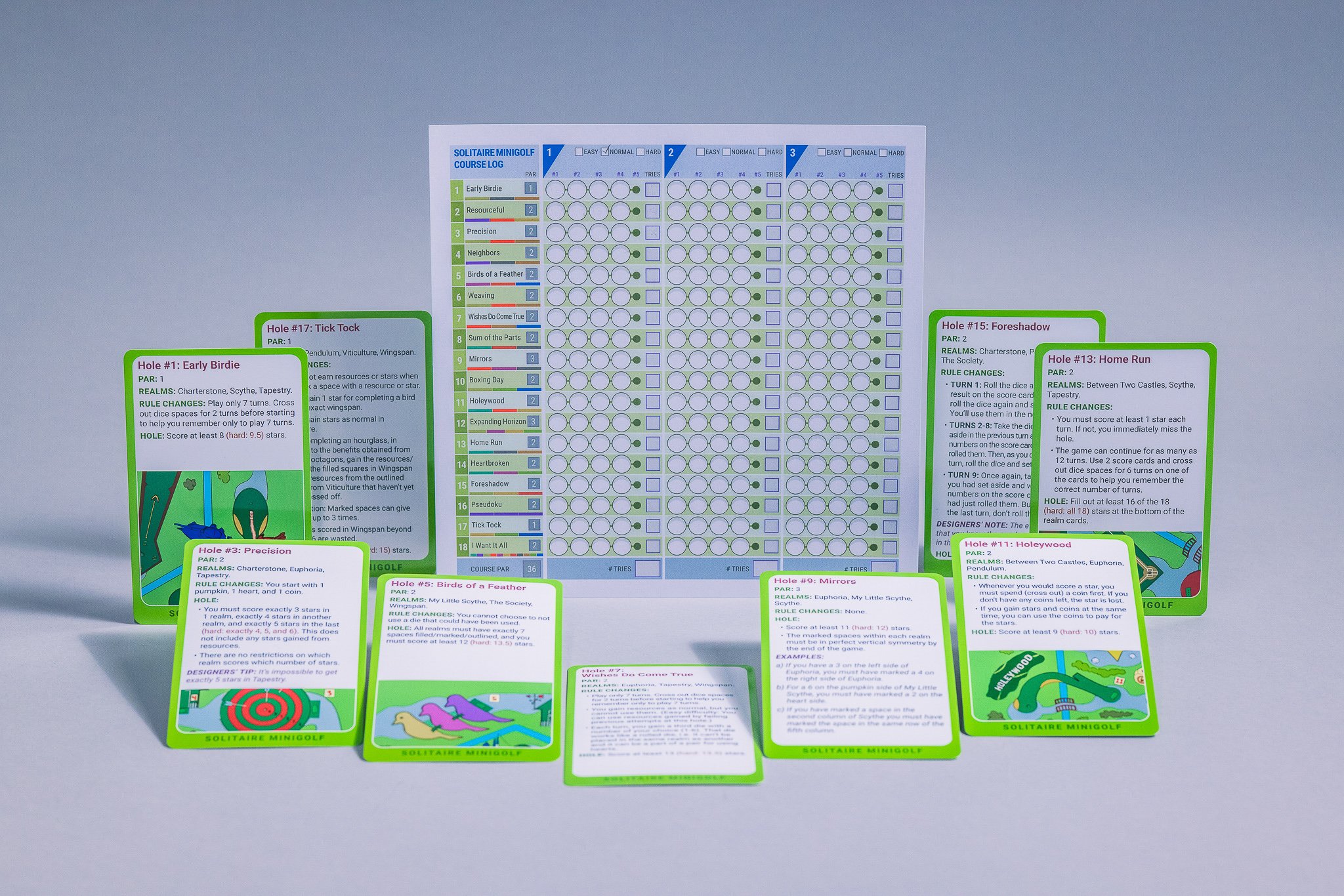Rolling Realms – First Impressions
Review copy provided by publisher
Everyone dealt with the early days of coronavirus differently.
Machine Gun Kelly went on a creative streak and released tons of small singles uploaded to YouTube. I know that because part of what I did was watch stuff like that…
But Jamey Stegmaier decided to design a board game. His time was maybe more productive than mine. Because out of that creative endeavor Rolling Realms was born. A roll-and-write game that started as a print-and-play but gained enough traction in the community to justify a production run and a fully-realized version straight from Jamey’s mind onto our shelves.
In this whimsically-illustrated adventure, players will progress through a series of mini-games all tied to other Stonemaier Games titles. Fill out wine orders in Viticulture. Upend the Societal pyramid in Red Rising. Fill up hourglasses in Pendulum. Across 11 realms of thematically-linked mini-games, players will compete to earn the most stars. It will be up to you to discover the key to the realms!
Designed by Jamey Stegmaier, artfully brought to life by Miles Bensky and Marius Petrescu, Rolling Realms is a game for 1-6 players that lasts 30-45 minutes.
Let’s check it out.
What It Does
Photo credits: Stonemaier Games
Players will compete across three rounds to see who can extract the highest star total from the nine realms. Each round consists of a player drafting three realms and using those three mini-games for nine turns.
On a turn, one player will roll the dice and all players will use the results on their realms. Two dice values. Two of the three realms used. Only using collected resources will allow players to subvert that central rule.
Each realm has its own rules for how dice can be used. They can all take values of 1-6, but the manner in which players can allocate them differs. The biggest hurdle in understanding Rolling Realms is grasping how each realm works and then how they can be exploited to more effectively interact with each other.
Placing a dice in one realm might earn a player the right resources in order to make the other dice placement more advantageous. Or resources gathered in earlier turns might enable a player to completely change the value of both dice rolled on a turn if they’re not initially helpful. Maybe one realm will be easier to use for resource collection while the other awards stars more readily. It’s all a matter of optimization as a player during each round.
And players will discover that some realms don’t play nicely with other realms. It’ll be up to the player to find the most efficient route through each realm to maximize points each round.
That’s all you need to know to get started!
How It Does It
There are three elements to a game of Rolling Realms: the dice that you roll, the realms to which you allocate those dice, and the resources you collect and then spend to manipulate the results of the dice roll and to create new dice for you to use.
Each round, players will get three realms to score from, but there are only two dice used each roll. So either one realm is unused on any particular roll of the dice or players will have to use one of the six resource-fueled powers to change that.
Pumpkins can be used to alter dice values and even use two dice in one realm (which is normally prohibited).
Hearts can be used to create additional dice based on the values rolled (doubles or any one number if enough hearts are spent).
And coins can be used to create additional dice based on the values rolled or the coins spent (either a total dice value of 7 or equal to the number of coins spent).
Half of the strategy in Rolling Realms is determining the best locations to allocate the dice each roll. And the other half is figuring out how best to use resources in order to influence or improve that first decision. And the interplay of those two halves is where the full puzzle of the game reveals itself.
And the multiplayer experience forces players to compete in augmenting the strengths while mitigating the weaknesses of their three realms in any given round. Over the course of three rounds, each player will use 9 of the 11 realms and the combined star totals from those three rounds will determine the winner.
In solo play, though, it’s a linear path through 18 holes of mini-golf where the realms used and the extra rules enforced are rigid and players must strive to do their best against those constraints.
The puzzle is bigger than the pieces that create it, which is part of the charm of Rolling Realms.
Why You Might Like It
If you’re a fan of Stonemaier Games, then this is an enjoyable way to revisit the entire catalog with a new perspective. The individual “realms” incorporate the theme and the mechanical spirit of their inspirations. And they all integrate in a satisfying way as players hunt for stars while juggling three different realms in a round.
It’s also easy to learn. The manipulation of the realms (and how they might work well together or interfere with each other) is something that takes a few plays to unlock, but the mechanical load of Rolling Realms is quite light. Players will roll dice, allocate them to the realms, and use resources when available to alter the dice values or add in more dice. That’s all players have to grasp.
Why You Might Not
On the flip side of things, if you aren’t familiar with much of the Stonemaier Games catalog, then the full weight of the design will be lost on you. The mechanics of the game function smoothly and you can still enjoy the gameplay experience, but the thematic backdrop will lose its luster.
There is no player interaction in the game. This is a benefit to some degree because it’s highly scalable with regards to player count since all someone needs is a set of realm cards and a dry-erase marker, but there are no shared goals, player interference, or other mechanics that encourage players to engage with each other.
Final Thoughts
Rolling Realms feels like it will fall into two categories for me—a game that I’ll be happy to play when there are larger groups of players, potentially using multiple copies of the game, and then a game that I’ll enjoy playing solo as I work through the Mini-Golf Automa mode that challenges one player to make it through 18-holes of Stonemaier golf.
I’ve played it several times so far and the most enjoyable time has been solo because I ultimately crave player interaction when there are other people around the table with me. Welcome To has shared goals that players can poach off of each other. Cartographers enables players to position monsters on their opponents’ maps. And other ____-and-writes manage to create that experience while utilizing the same focus on individual player mats.
So I miss that when I play Rolling Realms.
The game really does feel like a product of when it was conceived (in the midst of a pandemic) and that’s not a problem at all. Though the world has opened back up in some regions, digital gaming and remote board game experiences are still very much a thing. I’ve been playing D&D online for almost two years now and I don’t see that changing any time soon. So the potential of a game that can be played with people all over the world without much in the way of components or rules overhead is great. This is that “infinitely scaling” game.
I’d be happy to play the game online with friends from the industry and with strangers around the world. And I am content to continue chugging through the mini-golf game and improving my poor golfing skills as I move through the games and try to score under par. But as some aspects of my gaming life return to normal and there are other people around the table with me, I want to play something where we’re more invested in what’s happening as a single group rather than a group of individuals.
And also, I thoroughly enjoy several titles from Stonemaier Games. So much so, that when I’m dabbling with a diluted reflection of those games within Rolling Realms, I find myself wanting to play Red Rising, Tapestry, Pendulum, Euphoria, or Scythe.
At the end of the day, I wouldn’t say Rolling Realms is unsuccessful. Because it conjures up feelings of attachment and appreciation for Stonemaier Games while fulfilling a niche role in my board game collection.
I’m intrigued to play more and see how my opinions evolves!
If you want to check out Rolling Realms, you can learn more about Stonemaier Games or read what the community thinks on BoardGameGeek.
What is your favorite roll-and-write?
Let us know in the comments and give a recommendation for other games of which to share our first impressions.





